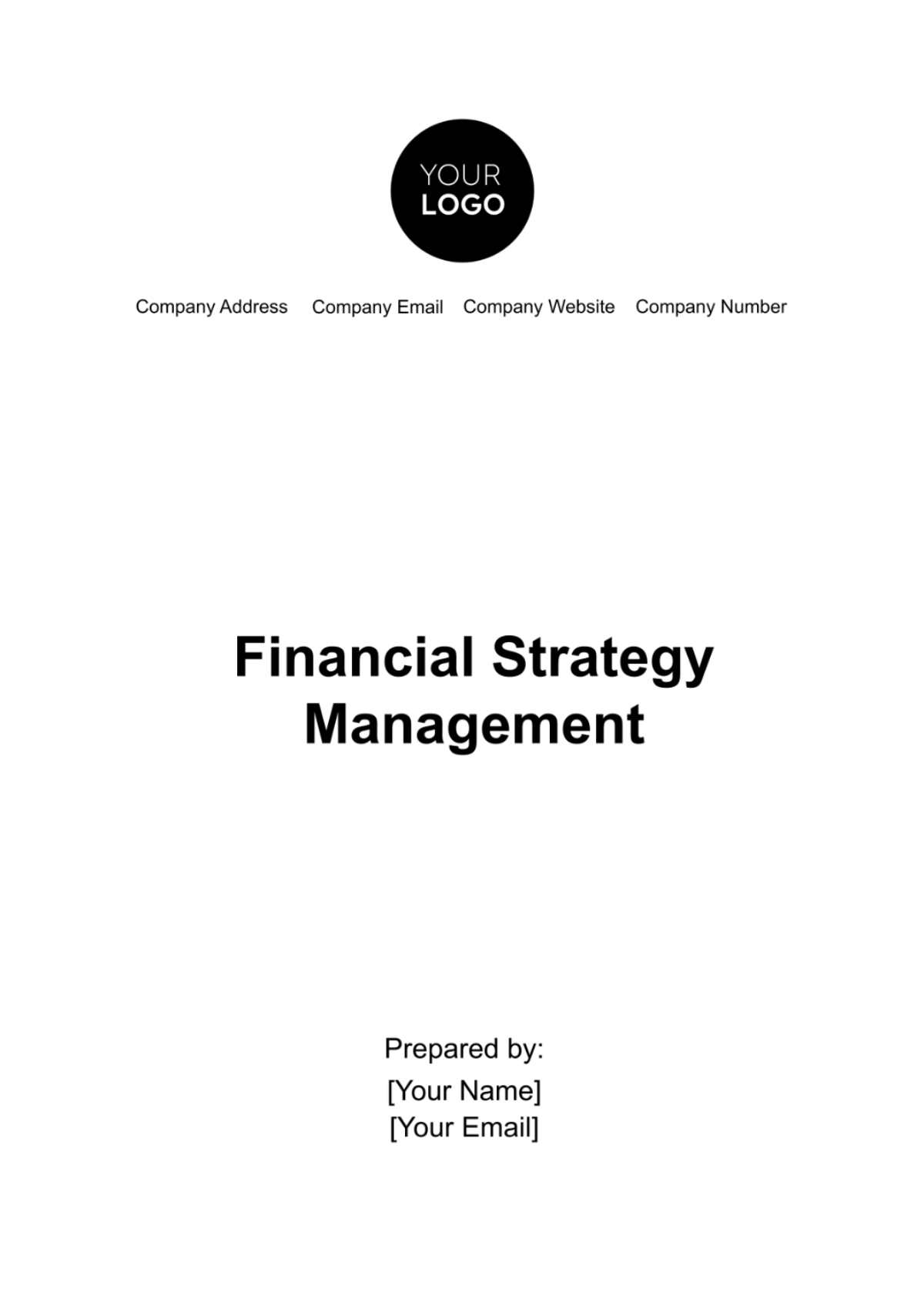Free Financial Strategy Management

I. Executive Summary
A. Overview of the Financial Strategy
Our Financial Strategy Management is a comprehensive framework designed to navigate the dynamic financial landscape while ensuring the sustained growth and resilience of [Company Name]. It encapsulates a judicious blend of risk mitigation, capital optimization, and strategic investments to foster a robust financial position.
B. Alignment with Overall Business Strategy
Our Financial Strategy Management is a comprehensive framework designed to navigate the dynamic financial landscape while ensuring the sustained growth and resilience of [Company Name]. It encapsulates a judicious blend of risk mitigation, capital optimization, and strategic investments to foster a robust financial position.
C. Key Objectives and Goals
Our key financial objectives are anchored in a vision of sustainable growth. Over the next three years, we aspire to achieve a [0]% increase in annual revenue, institute a [0]% reduction in operational expenses through efficiency measures, and optimize our capital structure to enhance financial flexibility and drive innovation.
II. Organizational Analysis
A. Current Financial Position
A thorough examination of our financial statements reveals a solid foundation. With total assets standing at $[0] million and a positive net cash flow of $[0] million, we are well-positioned for strategic initiatives. Key financial ratios, including a robust current ratio and a healthy ROA of [0]%, underscore our financial health.
B. SWOT Analysis
Our SWOT analysis identifies our strengths, such as strong brand recognition, and opportunities for growth, like market expansion. Simultaneously, we acknowledge weaknesses, such as reliance on a single supplier, and are prepared to address potential threats through proactive risk management and contingency planning.
C. Industry and Market Analysis
A detailed analysis of industry trends, competitor strategies, and market growth projections informs our strategic decisions. This in-depth understanding allows us to seize emerging opportunities, navigate market challenges, and position ourselves as a leader in a rapidly evolving landscape.
D. Regulatory and Economic Environment
Navigating the regulatory landscape and understanding economic factors are paramount. Our financial strategy ensures compliance with pertinent regulations and incorporates a keen awareness of economic shifts, allowing us to adapt swiftly to changes and mitigate potential impacts on our financial performance.
III. Strategic Financial Goals
A. Short-Term Goals (1-3 years)
In the short term, we are committed to achieving a [0]% increase in revenue through targeted marketing initiatives, implementing efficiency measures to reduce operational expenses by 15%, and improving working capital efficiency by [0]%. These goals are integral to our broader strategy of immediate financial strengthening.
B. Long-Term Goals (3-5+ years)
Looking ahead, our long-term goals involve expanding market share in [Target Region] by [0]%, optimizing our capital structure to achieve a specific debt-to-equity ratio, and fostering innovation through strategic investments in research and development. These objectives align with our vision for sustained, impactful growth over the coming years.
IV. Financial Planning
A. Budgeting
Our budgeting process involves meticulous planning, with a focus on optimizing resource allocation and aligning expenditures with strategic priorities. The operating budget provides a detailed breakdown of departmental expenses and revenue targets, while the capital budget outlines planned expenditures for the upcoming fiscal year. By integrating these budgets, we ensure a holistic approach to financial planning that supports our short and long-term goals.
B. Forecasting
In crafting financial forecasts, we leverage historical performance data, market trends, and economic indicators. These projections serve as valuable tools for anticipating revenue growth, identifying potential cost escalations, and adapting our financial strategy to changing circumstances. Through comprehensive forecasting, we strive to enhance our agility and proactively position ourselves in the face of evolving market dynamics.
C. Sensitivity Analysis and Scenario Planning
Acknowledging the uncertainty inherent in the business environment, we conduct sensitivity analyses and scenario planning to evaluate the impact of various economic scenarios on our financial performance. By stress-testing our financial models and contingency plans, we aim to fortify our resilience against unforeseen challenges and optimize our response strategies.
V. Capital Structure
A. Debt and Equity Mix
Our evaluation of the current debt and equity composition involves a careful assessment of the cost of capital and financial risk. We are committed to optimizing our capital structure, considering a balanced mix of debt and equity to minimize costs and enhance financial flexibility. Striking the right balance is crucial, and our approach reflects a prudent and strategic consideration of our capital components.
B. Cost of Capital Calculation
A meticulous calculation of the weighted average cost of capital (WACC) guides our decision-making. By understanding the cost implications of different funding sources, we seek opportunities for refinancing or restructuring to achieve a more favorable cost of capital. This proactive approach positions us to capitalize on cost-saving opportunities and maximize shareholder value.
C. Capital Allocation Strategy
Our capital allocation strategy is grounded in a disciplined approach to prioritize investments based on strategic importance and potential return on investment. Through clear frameworks and decision criteria, we ensure that our capital investments align with our overall business objectives. This strategic allocation is pivotal to achieving sustainable growth and maximizing the efficiency of our capital resources.
VI. Investment Strategy
A. Project Evaluation Criteria
Our investment strategy hinges on robust project evaluation criteria, including a minimum acceptable ROI, NPV considerations, and defined payback periods. These criteria serve as benchmarks for assessing the viability and alignment of potential investments with our financial goals. Rigorous evaluation ensures that our investments contribute meaningfully to our strategic objectives.
B. Prioritization of Capital Expenditures
A systematic approach guides the prioritization of capital expenditures, ensuring that investments align with our strategic priorities and risk tolerance. By considering the strategic significance of each project, potential returns, and associated risks, we aim to optimize the allocation of resources and enhance the overall effectiveness of our investment portfolio.
C. Risk Mitigation Strategies
Understanding the inherent risks associated with capital investments, we implement robust risk mitigation strategies. From comprehensive due diligence to the establishment of risk reserves, our approach is proactive and multifaceted. This ensures that potential risks are identified, assessed, and addressed, contributing to the overall success of our investment initiatives.
VII. Risk Management
A. Identification of Financial Risks
Our risk management framework involves a meticulous identification of financial risks, including market fluctuations, credit risks, and operational challenges. By comprehensively understanding potential risks, we are better equipped to implement targeted risk mitigation strategies that safeguard our financial stability and support sustainable growth.
B. Risk Mitigation Strategies
Our risk mitigation strategies are tailored to address specific financial risks. This includes strategic hedging to manage market risks, establishing rigorous credit assessment processes, and implementing robust operational controls. These proactive measures aim to minimize the impact of potential risks on our financial performance and ensure resilience in the face of uncertainties.
VIII. Performance Measurement
A. Key Performance Indicators (KPIs)
Defining and tracking key performance indicators (KPIs) forms the cornerstone of our performance measurement strategy. These indicators are carefully selected to align with our financial goals and strategic objectives. Regular monitoring of KPIs provides real-time insights into our financial performance, enabling timely adjustments and informed decision-making.
B. Balanced Scorecard Approach
We adopt a balanced scorecard approach to performance measurement, encompassing financial, customer, internal process, and learning and growth perspectives. This holistic view ensures that our performance metrics align with broader organizational objectives, fostering a balanced and comprehensive understanding of our overall success.
C. Regular Performance Reviews and Reporting
Scheduled performance reviews are integral to our commitment to transparency and accountability. Regular reporting to stakeholders, including the Board of Directors and investors, provides a comprehensive overview of our financial performance. This transparent communication fosters trust and enables stakeholders to make informed decisions based on a clear understanding of our financial health.
IX. Communication and Stakeholder Engagement
A. Internal Communication Plan
Internally, we emphasize a robust communication plan to keep teams informed and engaged. Regular team briefings provide updates on financial performance and strategic initiatives, fostering a sense of shared purpose. Additionally, targeted training programs enhance financial literacy across the organization, empowering teams to contribute effectively to our financial goals.
B. External Communication Plan
Externally, our communication plan revolves around shareholder meetings and investor relations. Shareholder meetings provide a platform for transparent communication regarding financial results and strategic updates. Our investor relations strategy focuses on building and maintaining open channels of communication, ensuring that investors are well-informed and confident in our financial stewardship.
X. Implementation Plan
A. Actionable Steps and Initiatives
The implementation plan outlines specific, actionable steps required to bring our financial strategy to fruition. Each initiative is carefully detailed, with assigned responsibilities and clear timelines. This structured approach ensures that the execution of our financial strategy is systematic, accountable, and aligned with our organizational goals.
B. Timeline and Milestones
A detailed timeline accompanies our implementation plan, delineating key milestones and deadlines. This timeline serves as a roadmap for the execution of initiatives, allowing for proactive monitoring and adjustments as needed. Clear milestones provide a measurable framework for tracking progress and celebrating achievements along the journey.
C. Resource Allocation
Efficient resource allocation is a cornerstone of our implementation strategy. Human and financial resources are allocated judiciously, ensuring that each initiative receives the necessary support for success. Continuous monitoring of resource utilization allows for dynamic adjustments, optimizing our ability to execute our financial strategy effectively.
XI. Monitoring and Adaptation
A. Regular Performance Monitoring
Regular performance monitoring is ingrained in our corporate culture, with real-time tracking of key performance indicators (KPIs) and financial metrics. Through a robust system of dashboards and reports, we ensure a continuous pulse on our financial health, allowing for timely identification of trends, successes, and areas that may require adjustment.
B. Feedback Mechanisms
We actively seek feedback from internal and external stakeholders to enhance our financial strategy. Internally, regular forums and surveys are conducted to gather insights from employees, fostering a culture of open communication. Externally, we maintain channels for customer and supplier feedback, allowing us to adapt our financial approach based on market perceptions and demands.
C. Periodic Review and Adaptation of Financial Strategy
Our commitment to agility and adaptability is reflected in our periodic reviews of the financial strategy. Scheduled reviews, aligned with the fiscal calendar, provide opportunities for reflection on market dynamics, competitive landscape shifts, and internal performance. This iterative approach allows us to refine our strategy continuously, ensuring it remains dynamic and responsive to evolving conditions.
XII. Contingency and Crisis Management
A. Contingency Plans for Financial Challenges
Contingency planning is integral to our risk management approach. We have detailed contingency plans in place to address potential financial challenges, including economic downturns or unexpected disruptions. These plans outline specific actions, responsibilities, and communication protocols to ensure a swift and coordinated response during times of financial stress.
B. Crisis Management Protocols
Our crisis management protocols are designed to provide a structured and effective response in the face of financial emergencies. These protocols involve the immediate activation of crisis management teams, clear communication channels, and pre-defined decision-making processes. Regular drills and scenario simulations ensure our teams are well-prepared to navigate crises, safeguarding our financial stability and reputation.
XIII. Legal and Compliance Considerations
A. Compliance with Financial Regulations
Ensuring compliance with financial regulations is a top priority. Regular internal audits, legal reviews, and collaboration with legal counsel ensure that our financial strategy aligns with relevant regulations. By staying proactive in understanding and adhering to financial laws, we mitigate legal risks and foster a culture of integrity and transparency.
B. Legal Review of Financial Strategy
Engaging legal counsel for a comprehensive review of our financial strategy is a standard practice. This legal scrutiny goes beyond compliance, addressing contractual obligations, risk disclosures, and potential legal implications. This proactive legal review enhances the robustness of our financial strategy, instilling confidence in stakeholders and mitigating legal uncertainties.
XIV. Conclusion
A. Recap of Key Points
In conclusion, our Financial Strategy Management document underscores our commitment to financial excellence, resilience, and long-term value creation. Key points include the alignment of financial goals with broader business objectives, the pursuit of sustainable growth, and the integration of risk management and compliance considerations.
B. Commitment to Continuous Improvement
We conclude with a steadfast commitment to continuous improvement. Acknowledging the dynamic nature of the business environment, we embrace a culture of learning and adaptability. By fostering innovation, monitoring feedback, and regularly refining our financial strategy, we position ourselves to navigate challenges and capitalize on opportunities in an ever-evolving landscape.
- 100% Customizable, free editor
- Access 1 Million+ Templates, photo’s & graphics
- Download or share as a template
- Click and replace photos, graphics, text, backgrounds
- Resize, crop, AI write & more
- Access advanced editor
Unlock your financial potential with Template.net's Financial Strategy Management Template. This editable and customizable tool empowers you to craft bespoke strategies seamlessly. Tailor your financial roadmap effortlessly with our AI Editor Tool, ensuring precision and adaptability. Elevate your financial game today with ease and efficiency.





























